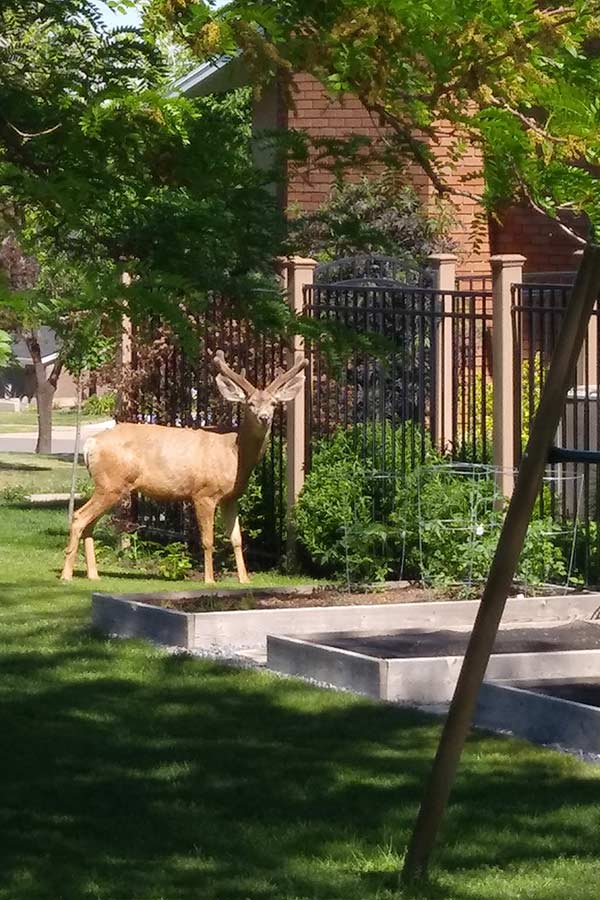How to keep deer out of your garden and other drought-related wildlife tips
Salt Lake City — The ongoing drought may lead to more wildlife traveling into Utah neighborhoods in search of food and water. Whether you want to keep the deer from eating all your garden vegetables and flowers or whether you're interested in ways to help wildlife during this hot, dry summer, here are a few things you should know.
Many wildlife species are impacted by the extreme drought conditions that Utah is facing this year, particularly deer. The limited availability of food and water can lead to a reduced number of newborn fawns and fewer fawns that survive their first year. The harsh conditions can also reduce the number of huntable buck deer and result in lower overall deer population numbers. Drought can also impact antler growth for buck deer because a sparse food supply provides fewer nutrients, which bucks need to grow antlers. Pregnant does also struggle with the decreased food supply during drought years, and if their body condition is poor during pregnancy, their male offspring may have relatively smaller antlers, even after reaching maturity.
How to reduce conflicts with deer in your garden
In order to find alternate food sources, deer and other big game animals may end up in people’s yards or gardens this summer. If you want to try to save your plants and want to minimize any property damage from these wildlife visits, here are a few tips:
- Building an 8-foot fence around your garden or yard is the most effective method, and is probably the only reliable way to keep deer out of your garden.
- Another fairly effective technique is to install a motion-activated sprinkler.
- People can also try planting unpalatable vegetation around the perimeter of their gardens to deter deer from eating additional plants.
How to help wildlife during a drought
While some people may want to prevent deer and other wildlife from eating their lawns or gardens, others may be looking for ways they can help hungry and thirsty animals this summer. While it may be tempting to provide feed or water for these animals, it can lead to unsafe situations for the animals and people.
"The best way you can help wildlife is by letting animals stay wild," Utah Division of Wildlife Resources Wildlife Section Chief Justin Shannon said. "Don't approach them, and don't try to feed them. These animals have evolved to be able to survive numerous weather conditions and to make it on their own. Often people's good intentions wind up doing more harm than good for the wildlife. Not to mention, it can be really dangerous when deer, moose or bears become habituated and lose their fear of people."
Visit the DWR website for deer-friendly landscaping ideas if you live in an area frequented by big game animals.
If you notice deer or elk that look sickly, are injured or are acting aggressively, you should report it to the nearest DWR office. If you encounter a cougar that has killed something in a neighborhood or yard — or it is exhibiting aggressive or threatening behavior — you should report it. If you see a bear in a residential area within the foothills or canyons, they should only be reported if they are being aggressive or if they are getting into trash, fruit trees or causing damage. You should report a bear that has wandered into lower-elevation areas and is within city limits or in a heavily-populated area. Visit the DWR website to learn about other common wildlife scenarios where you should contact the DWR.
What the DWR is doing to minimize drought impacts to fish and wildlife
The DWR is taking proactive measures to help fish and wildlife species during the severe drought this year. Here are some examples:
- Making changes to the fishing regulations to allow anglers to harvest more fish at drought-impacted waterbodies and also adjusting fish stocking throughout the state. By stocking fish in more drought-resistant waterbodies, the DWR hopes to prevent fish die-offs due to low water levels and hot water temperatures.
- Issuing fewer general-season deer permits for this year's hunts.
- Temporarily closing wildlife management areas to campfires and recreational target shooting with a firearm, in an effort to prevent wildfires during the extremely dry conditions. The DWR is monitoring conditions closely, and these activities will again be allowed as soon as drought conditions improve and it is safe to do so.
- Working hard to alleviate damage on agricultural properties. The DWR will use all available management tools and programs to assist private landowners and agricultural producers to minimize wildlife damage to their properties.
- Installing water guzzlers and supplying water in critical locations where water is currently unavailable.

















